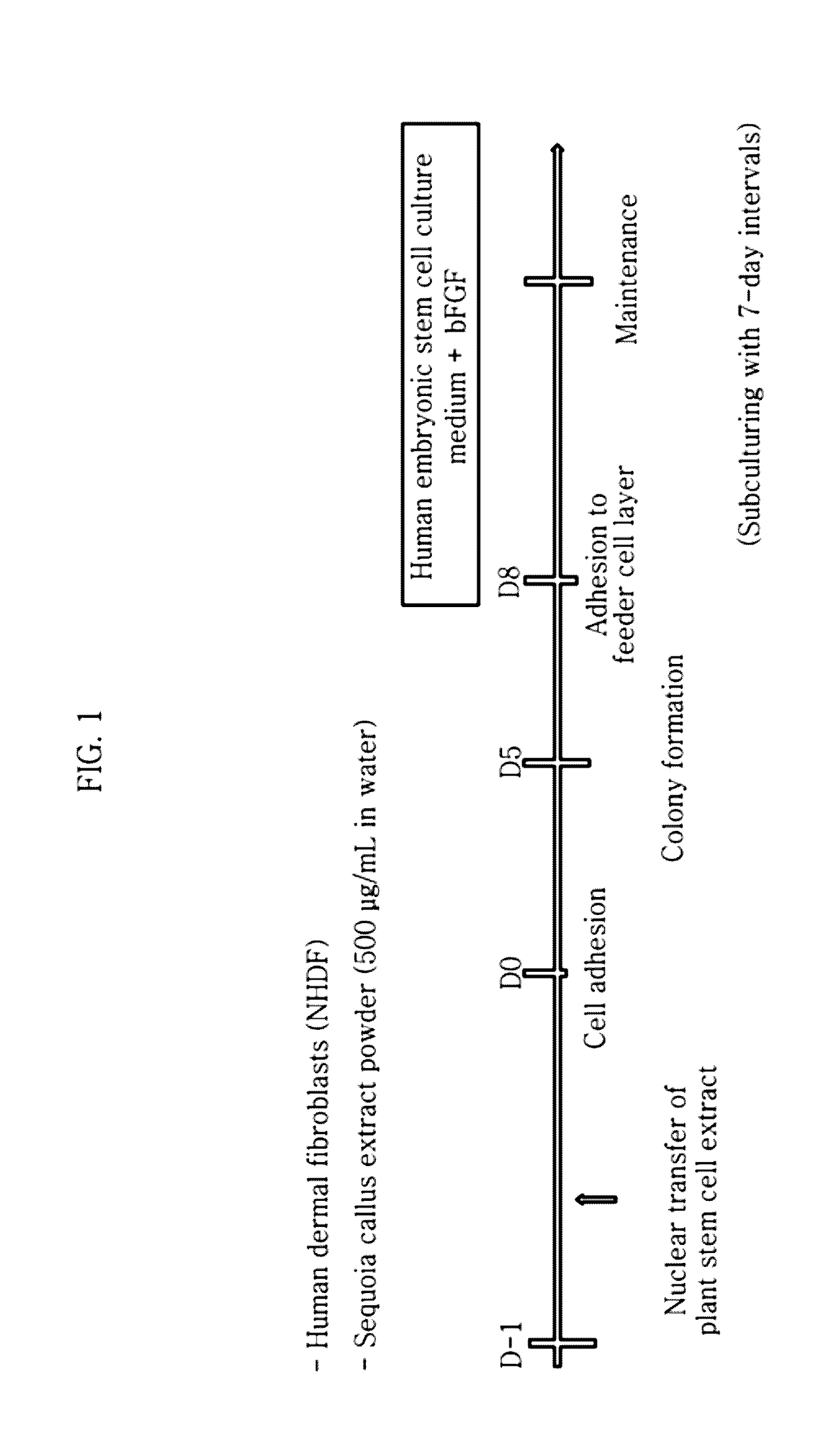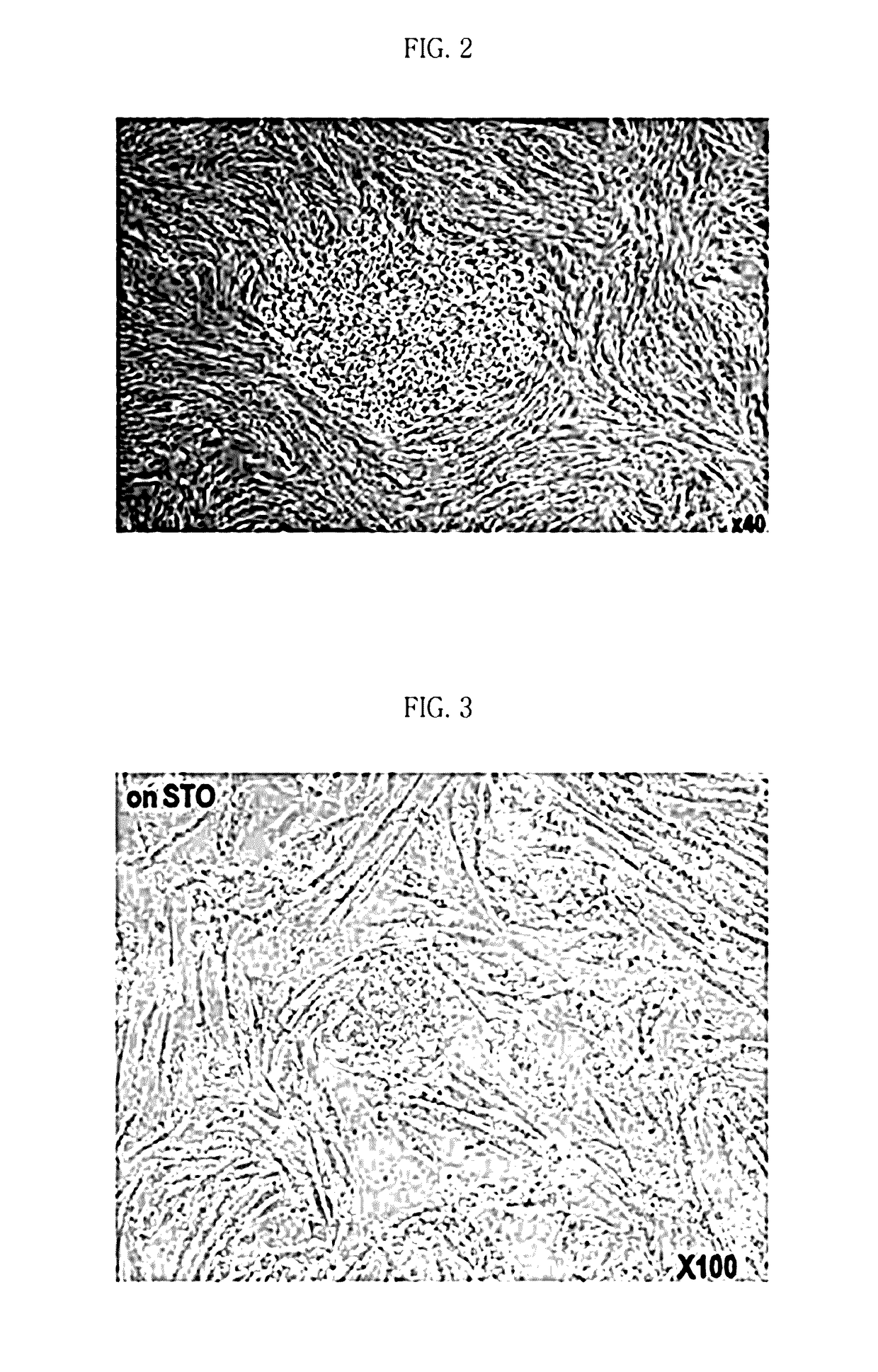Method for inducing pluripotent stem cells and pluripotent stem cells prepared by said method
a technology of pluripotent stem cells and induction methods, which is applied in the direction of antinoxious agents, drug compositions, skeletal/connective tissue cells, etc., can solve the problems of inability to avoid immune rejection due to lack of immunocompatibility between individuals, inefficient somatic cell nuclear transfer, and serious cell stability problems in fusion with es cells
- Summary
- Abstract
- Description
- Claims
- Application Information
AI Technical Summary
Benefits of technology
Problems solved by technology
Method used
Image
Examples
example 2
[Example 2] Preparation of Pluripotent Cells Such as Embryonic Stem Cells by Culturing Extract-Injected Cells
[0161]The extract-injected cells were incubated in a normal cell culture medium wherein DMEM (Dulbecco's modified Eagle's medium) was supplemented with 10% FBS, 50 U / mL penicillin and 50 mg / mL streptomycin in an incubator maintained at 37° C. and 5% CO2. The adult-derived cells (human-derived dermal fibroblasts) into which the plant stem cell extract (callus powder) was injected were cultured on a dish coated with 0.1% gelatin. The medium was replaced after the first two days. After culturing for 10 days while replacing the medium every day, the cells were transferred to a feeder cell (STO cell) layer treated with mitomycin C (MMC) at a ratio of 1:2. Then, the cells were transferred to a new feeder cell layer with 7-day intervals while replacing DMEM (Dulbecco's modified Eagle's medium) / F12 supplemented with 20% KSR (knockout serum replacement), 2 mM L-glutamine, 0.1 mM nones...
example 3
[Example 3] Characterization of Induced Pluripotent Stem Cells (Gene Expression Analysis)
[0164]The cultured cells were recovered and total RNA was separated by using the TRIzol reagent (Invitrogen). After synthesizing cDNA through reverse transcription polymerase chain reaction (RT-PCR), PCR was conducted using primers specific for the Nanog and Oct3 / 4 genes and the GAPDH gene as a control gene. The expression of these genes was analyzed by electrophoresing the PCR product on an agarose gel. The result is shown in FIG. 7.
[0165]As seen from FIG. 7, the pluripotent stem cells (hiPS) induced by the method of the present disclosure showed expression of the Nanog and Oct3 / 4 genes, which are characteristic of embryonic stem cells (hES).
[Example 4] Preparation of Sequoia (Sequoiadendron giganteum) Callus Extract Containing Shikimic Acid
[0166]20 mg of the sequoia callus powder of Example 1 was dissolved in 1 mL of a DMSO solvent. Similarly, 1 g of the sequoia callus powder was dissolved in ...
formulation example 1
[Formulation Example 1] Soft Capsule
[0201]40 μg of shikimic acid or the sequoia callus extract of Example 4, 9 mg of vitamin E, 9 mg of vitamin C, 2 mg of palm oil, 8 mg of hydrogenated vegetable oil, 4 mg of yellow beeswax and 9 mg of lecithin were mixed according to a commonly employed method, and 400 mg of the mixture was filled per capsule. Separately from this, a soft capsule sheet was prepared from 66 parts by weight of gelatin, 24 parts by weight of glycerin and 10 parts by weight of a sorbitol solution and the mixture was filled therein to prepare a soft capsule in which 400 mg of the composition according to the present disclosure is contained.
PUM
| Property | Measurement | Unit |
|---|---|---|
| concentration | aaaaa | aaaaa |
| concentration | aaaaa | aaaaa |
| concentration | aaaaa | aaaaa |
Abstract
Description
Claims
Application Information
 Login to View More
Login to View More - R&D
- Intellectual Property
- Life Sciences
- Materials
- Tech Scout
- Unparalleled Data Quality
- Higher Quality Content
- 60% Fewer Hallucinations
Browse by: Latest US Patents, China's latest patents, Technical Efficacy Thesaurus, Application Domain, Technology Topic, Popular Technical Reports.
© 2025 PatSnap. All rights reserved.Legal|Privacy policy|Modern Slavery Act Transparency Statement|Sitemap|About US| Contact US: help@patsnap.com



